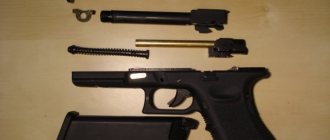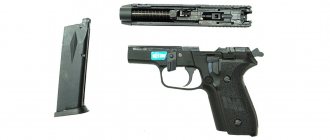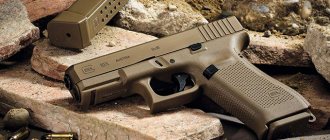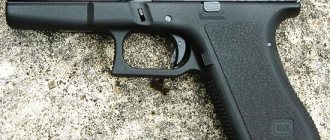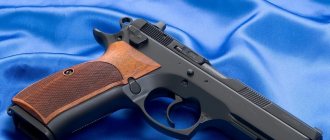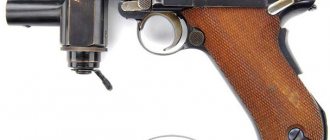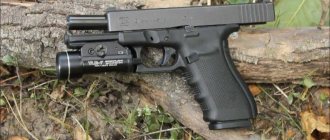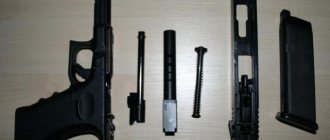Glock 17 is the original creation of the Glock small arms company, released for the new needs of the Austrian army in 1979. The main goal was to replace outdated weapons such as the Walter P38 with a fundamentally new model.
As a result, the Glock 17 turned out to be a very high-quality and easy-to-use development, thereby earning recognition from the Austrian army and many police officers around the world. Also, thanks to its technical characteristics, the pistol has gained great popularity among the civilian population as an excellent means of self-defense.
History of creation
Glock GmbH was founded in 1963 by an engineer named Gaston Glock. The company, based in Austria, manufactured steel and plastic parts. In the 70s, Glock began producing knives, training grenades and other products for the Austrian military.
Thanks to his connections, which Glock maintained and constantly strengthened with the military, he was led to new opportunities. In 1980, he received an official proposal from the Austrian military, which proposed developing a new pistol.
The Army wanted to replace their old World War II models (Walter P38).
The Austrian Ministry of Defense has formulated a list of a number of criteria for a new generation pistol:
- The design had to be as simple as possible.
- The pistol was to use NATO standard 9x19mm parabellum cartridges.
- Magazines should not require any means of loading.
- Magazines had to have a minimum of eight rounds.
- The pistol should be comfortable to shoot with both left and right hands.
- The pistol must be absolutely safe from accidental discharge due to impact from a fall from a height of 2 m onto a steel plate.
- Disassembly of major parts for maintenance and reassembly must be possible without the use of any tools.
- Maintenance and cleaning of the gun was carried out without the use of tools.
- The pistol design must not exceed 58 individual parts (P38 equivalent).
- Sensors, measuring instruments and precision testing devices should not be necessary for long-term gun maintenance.
- The manufacturer was required to provide the Department of Defense with a complete set of engineering drawings. They had to be provided with all the necessary explanations for making a pistol.
- All components are completely interchangeable between pistols.
- During the first 10,000 shots, no more than 20 delays were allowed, no matter how minor, which could be eliminated without the use of any tools.
- After firing 15,000 rounds of standard ammunition, the pistol had to be inspected for wear. The gun will then be used to run an overpressure test bench generating 5,000 bar (500 MPa, 73,000 psi). Normal operating pressure for the 9 mm NATO is estimated at 2,520 bar (252 MPa, 36,500 psi). During this inspection, critical components must continue to function properly and meet specifications or the gun will be rejected.
Gaston Glock had no experience in designing firearms, but nevertheless accepted the order and began creating a new pistol for the Austrian military. Glock assembled a team to pinpoint the features and qualities that made up the perfect pistol.
A few months later, Glock developed a prototype. The company introduced a semi-automatic model no. 17 for approval and review by various committees of the ministry.
The model was so named because it was Glock's 17th patent.
The tests carried out by competing firms were tough and very demanding.
Ultimately, the Austrian Ministry of Defense decided to go with the Glock variant, and the Model 17 became the pistol for the Austrian military. Thus, Mr. Glock and his team became winners in the competition to create a new pistol, ahead of many Austrian and international companies.
Video - history of creation
Since 1982, the Austrian military and police began to use these firearms en masse, and just a few years later the brand spread throughout the world. So, soon after the appearance of the Glock, the Norwegian and Swedish armed forces wanted to adopt it. Today, the army and police in more than 30 countries are armed with this pistol.
Glock generations
Over the years, the Glock 17 has gone through various modifications. Glock users simply gave the nickname "generations". The company itself has since adopted the generational term and also released its latest Glock 17 as “Gen 4,” meaning “generation 4.”
Time list:
- 1982 - Glock releases the Glock No. 17 model. A distinctive feature was the evenly distributed roughness on the handle. This is a model known as Gen 1. About 500 thousand examples were produced.
- 1988 - Gen 2. One significant change is that there is now one recoil spring rather than two on the Gen 1. The grip is also different as Glock has added knurls that create vertical and horizontal lines, which greatly improves retention pistol in hand. In the second generation, the pistol was adopted by the FBI, as well as the armies of the Scandinavian countries.
- 1996 - Gen 3. In addition to corrugations, the pistol received the ability to mount tactical flashlights and laser designators. For better grip in the hand, the company made a recess in the upper part of the handle for the thumb.
- 2010 - Gen 4 released. This generation has changed the most in relation to the previous pistols in this line. In the knurled handle, the distance between the points has increased, now there are 25 per square centimeter. This corrugation is called RTF2. The magazine release button has been made larger and more convenient. Also on the fourth generation Glock 17 they began to install two springs of different diameters (on one guide rod with a separator between them), instead of one return one. Thus, the company has achieved a reduction in the recoil effect of the pistol when firing and an increase in the survivability of each individual spring.
Specifications
| Weight | 650 gr., (without cartridges) 900 gr., (loaded) |
| Length | 186 mm |
| Barrel length | 114 mm |
| Width | 33 mm |
| Height | 138 mm |
| Cartridge | 9×19 mm Parabellum (+P, +P+) |
| Caliber | 9 mm |
| Work principles | recoil of the barrel during its short stroke |
| Initial bullet speed | 375 m/s |
| Sighting range | 50 m |
| Type of ammunition | magazine for 17+1 (standard), 19+1 or 33+1 rounds |
| Aim | removable open |
Glock 24 pistol
| Glock 24 second generation (early release) |
In 1990, it was one of the first to release Glock 22 and Glock 23 pistols chambered for the new .40 S&W cartridge.
Glock 17L
The .40 S&W cartridge, proposed in 1990, almost immediately became widely used as a universal civilian-police ammunition (according to experts, it became the “golden mean” between the popular 9x19 mm Parabellum and .45 ACP cartridges), and Glock pistols models 22 and 23 has attracted high interest in the US arms market.
In 1994, it expanded the range of pistols chambered for the .40 SW cartridge by releasing the “sports” model Glock 24. The new pistol received a 153 mm barrel, an elongated bolt housing and a magazine with a capacity of 15 rounds.
The design of the Glock 24 pistol is another modification of the basic Glock 17 model. At the same time, the Glock 17L pistol was taken as the basis, with which the Glock 24 has identical dimensions.
Glock 24 second generation
The automatic weapon, as in previous models, works due to the recoil of the barrel during its short stroke. The barrel bore is locked by the upper protrusion of the barrel entering the window of the bolt casing. The barrel bore is unlocked by lowering its breech down using the lower breech boss and axis during recoil of the barrel.
The U-shaped shutter casing is made of steel using high-precision casting and subjected to special treatment to increase corrosion and wear resistance.
Barrel with a hexagonal bore and six rifling. Just like the shutter casing, it is treated with a special tenifer coating. By lengthening the barrel in the Glock 24, compared to previous models, it was possible to achieve increased accuracy of fire.
The pistol has a striker-fired trigger mechanism, the so-called “Safe Action”, with 3 automatic safeties, including one on the trigger. A feature of the “safe action” trigger is that during the reloading cycle of the pistol, the firing pin is only partially cocked, while it is blocked using an automatic safety lock. The firing pin is re-cocked only when the trigger is pressed, while the firing pin remains blocked from moving forward until the trigger is fully pulled. Thus, it is possible to achieve a uniform force on the trigger from the first to the last shot, which has a positive effect on shooting accuracy. The standard trigger force is 2.0 kg.
Open-type sighting devices are mounted on the flat upper surface of the bolt housing and include a replaceable permanent front sight with a sight. As standard, the front sight is equipped with a luminous dot, and the rectangular slot of the sight is framed by a luminous frame. Since the Glock 24 is designed for target shooting, the sight can be replaced with an adjustable one.
| Glock 24 third generation |
The weapon is normally supplied with ammunition from a detachable box magazine with a double-row arrangement of 15 rounds in a checkerboard pattern. In addition, it is possible to use a magazine with a single-row arrangement of 10 rounds.
| Caliber, mm | .40SW |
| Length, mm | 225 |
| Barrel length, mm | 153 |
| Height with magazine, mm | 138 |
| Width, mm | 30 |
| Weight, kg - without magazine - loaded | 0.757 1.082 |
| Magazine weight, kg - without cartridges - loaded | 0.078 0.325 |
| Store, count. cartridges | 15 (17); 10 |
| Sighting range, m | 50 |
The pistol frame, together with the handle and trigger guard, is made of high-strength polymer material (plastic) of the monocoque type. The guide frames along which the steel shutter-casing moves are reinforced with steel inserts.
Early releases of the pistol had handles with grooved front and rear surfaces. Third-generation pistols have grooves for fingers on the front side of the handle and small “shelves” for the thumb on their sides, and under the barrel there are guides for attaching various accessories (laser designator, tactical flashlight, etc.).
All metal parts of the Glock 24 model are processed using Tennifer technology. As a result of this treatment, the surface to a depth of 0.05 mm acquires a hardness of about 69 Rockwell units (for comparison, the hardness of industrial diamonds is 71-72).
Since the pistol was created specifically taking into account the characteristics of the cartridge used, its reliability remained as high as that of previous models of the Glock family.
| Glock 24C |
Glock 24C
In addition to the main model - Glock 24, a variant of the Glock 24C was created (the letter “C” in the name of the pistol means “Compensated”), differing only in the integrated compensator. The purpose of the compensator is to reduce recoil and muzzle flip, so the Glock 24C pistol is aimed primarily at beginner or recoil-sensitive shooters, as well as those who compete in practical shooting competitions. However, it can be used for hunting, recreational shooting, self-defense, etc.
The compensator in the Glock 24C is made in the form of four elliptical holes in the upper part of the barrel, located under the “window” of the bolt housing. The weight and size characteristics and appearance of the Glock 24C are the same as those of the Glock 24. The initial velocity of a bullet in a pistol with a compensator is reduced by 2-3% compared to the main model, and a shot from it is accompanied by a strong flash. However, in return, the shooter gets the opportunity to fire as quickly as possible, since all negative impacts on him are minimized.
| Glock 24C |
Design features
Most Glock parts are made of high-strength nylon-based polymer. The rest of the pistol is made of steel. The polymer (called polymer-2) in weapons is the invention of Gaston Glock himself. The substance was unconventional when it was first introduced.
Over time, it became clear that Glock knew what it was doing when the company released this revolutionary new pistol. Polymer-2 is a substance that is primarily stable. It is more elastic than most different steel alloys. This substance can withstand very high temperatures, shock and various liquids.
The gun is treated with Tenifer, a substance that is also extremely durable and is a standard in the firearms industry.
Once the finishing is complete, the gun has a matte gray appearance on its surface, and this is when the final finish is applied to the gun to give it its final look.
Finishing the gun using tenifer technology helps protect the steel parts inside. This means you can even technically fire this weapon underwater. Glock steel parts using the Tenifer treatment are more resistant to corrosion than similar pistol parts that have other finishes or treatments, including Teflon, blue, hard chrome plating or phosphates.
During 2010, Glock switched from the Tenifer nitriding process to a salt bath. After completion of the nitriding process, a black decorative surface is applied. The nitriding treatment will remain, protecting the gun parts, even if the decorative surface wears off. Due to the simplicity and reliability of the design, the gun can be completely disassembled and reassembled and technical inspection can be carried out without improvised means.
When disassembled, the pistol has 33 parts, including the magazine.
The pistol is equipped with a standard magazine for 17 rounds, but if necessary, it is possible to use larger magazines for 19 and 33 rounds.
Thanks to Glock's innovative solutions in the use of polymers, it was possible to significantly reduce the weight of the pistol. For comparison, the Beretta 92 with a 15-round magazine weighs 950 g when unloaded, while the Glock 17 has a clean entire pistol of 650 g, and with a full magazine 900 g. The pistol is so light that 25% of its total weight is ammunition .
The Glock 17 pistol has earned worldwide fame and respect due to its high reliability of all components and mechanisms. At the end of the 20th century, it was believed that if a pistol can fire up to 40 thousand shots without any problems, then it can be considered wear-resistant and reliable, but the Glock pistol exceeded all expectations, firing up to 350 thousand shots, which is many times higher than the standard indicators. This advantage is due to the widespread use of polymer components and unique barrel production technology patented by Glock.
In parts that are subject to the greatest load, the plastic is reinforced with special metal plates.
Steel inserts are inserted into the guide frame along which the shutter casing moves. To carry out partial disassembly of the pistol (disconnecting the bolt barrel along with the return spring from the frame), there are special latches that are located on the pistol frame, near the trigger guard.
Encyclopedia of weapons
Glock 33 pistol, Subcompact model
Tactical and technical characteristics of Glock 33: Caliber, mm - .357 SIG (9×22) Length, mm - 160 Barrel length, mm - 88 Height, mm - 106 Width, mm - 30 Rifling - right-handed, hexagonal, pitch mm, - 406 Weight without cartridges, g - 620 Equipped weight, g - 755 Magazine, cartridges - 9, optional 13; 15
In 1998, continuing the series of Glock family pistols chambered for .357 SIG (Glock 31 and Glock 32), it released the ultra-compact Glock 33 model chambered for this ammunition. The Glock 33 pistol is designed to be carried concealed under light clothing as a backup or main pistol, while possessing high firepower for a weapon of this class and the stopping effect of the bullet of the cartridge used.
The subcompact (Subcompact - small-sized) pistol Glock 33 in its design is another modification of the basic model Glock 17 adapted for the .357 SIG cartridge. However, unlike the full-size model, changes were made to the Glock 33 pistol due to a reduction in the size of the weapon: it was significantly shortened barrel, bolt casing, frame and handle.
The front and rear edges of the bolt casing are rounded so that the contours of the weapon do not stand out when carried concealed.
In addition to the main return spring, an additional buffer was also used to soften the recoil. Externally, the Glock 33 is practically no different from its immediate predecessor, the Glock 27 in .40 S&W caliber, but the higher operating pressures of the .357 SIG cartridge necessitated the need to increase the strength of the barrel and individual structural elements.
The automatic operation of the Glock 33 model, as in previous pistols of the Glock family (except for the .380 Auto caliber), works due to the recoil of the barrel during its short stroke. The barrel bore is locked by the upper protrusion of the barrel entering the window of the bolt casing. The barrel bore is unlocked by lowering its breech down using the lower breech boss and axis during recoil of the barrel.
The U-shaped shutter casing is made of steel using high-precision casting and subjected to special treatment to increase corrosion and wear resistance. All metal parts of the Glock 33 model are processed using Tennifer technology. As a result of this treatment, the surface to a depth of 0.05 mm acquires a hardness of about 69 Rockwell units. The barrel, as well as the bolt casing, is treated with a special Tennifer coating.
The pistol has a striker-fired trigger mechanism, the so-called “Safe Action”, with 3 automatic safeties, including one on the trigger. A feature of the “safe action” trigger is that during the reloading cycle of the pistol, the firing pin is only partially cocked, while it is blocked using an automatic safety lock.
The firing pin is re-cocked only when the trigger is pressed, while the firing pin remains blocked from moving forward until the trigger is fully pulled. Thus, it is possible to achieve a uniform force on the trigger from the first to the last shot, which has a positive effect on shooting accuracy. The standard trigger force is 2.5 kg.
Open-type sighting devices are mounted on the flat upper surface of the bolt housing and include a replaceable permanent front sight with a sight. As standard, the front sight is equipped with a luminous dot, and the rectangular slot of the sight is framed by a luminous frame.
The pistol is normally fed with ammunition from a detachable box magazine with a double-row arrangement of 9 rounds in a checkerboard pattern. In addition, a magazine with a capacity of 13 and 15 rounds, used in Glock 31 and Glock 32 pistols, is used.
The pistol frame, together with the handle and trigger guard, is made of high-strength polymer plastic. The guide frames along which the steel shutter-casing moves are reinforced with steel inserts.
The short pistol grip provides support for only two fingers. To compensate for this, the handle is equipped with front and side finger grooves.
The Glock 33 pistol was created specifically taking into account the characteristics of the cartridge used, therefore it has the same qualities as all models of the Glock family - simplicity, safety in handling and ease of maintenance, as well as a long service life and very high reliability in difficult operating conditions.
The Glock 33 received the same success as the .357 SIG cartridge. The pistol combines small dimensions and high stopping power of the cartridge used with a moderate recoil force, as well as excellent performance characteristics.
Compactness and lightness make constant concealed carrying of a pistol (invisible even under a T-shirt) comfortable and not tiring. In accordance with the tasks assigned to it, it has well-balanced combat and service-operational qualities.
However, the Model 33's recoil is stronger than larger models with more weight and more ergonomic handles. The small handle does not provide support for the little finger, which negatively affects shooting accuracy, but when using magazines of larger capacity, or those that have a cover with a protruding front part for resting the little finger, the hold becomes more stable.
The Glock 33 pistol was primarily designed for the consumer market, but has become an ideal compact weapon for law enforcement officers as well. Police in different countries began to use this pistol as a backup weapon.
‹ Glock 32 Up Glock 34 ›Possible additional gadgets and tuning
The Glock 17 pistol has a wide selection of magazines that have increased ammo capacity and weight for faster magazine removal from the grip chamber, which can save important fractions of a second in critical moments.
One of the most common upgrades to a pistol is the installation of flashlights or laser designators by attaching them to a bar under the barrel. Such devices began to appear in the 3rd generation of Glock pistols. It has become a modern fashion to install a knife rail.
There are several comprehensive tuning models for the Glock line of pistols.
Viridian C5L is a device that includes a flashlight with a power of 110 lumens and a green laser designator, its brightness and clarity is determined by 5 mW. Thanks to this device, you can point out a target at a distance of up to 100 meters during the day and at night up to 1500 meters.
Tactical stock GRL-400, thanks to the stock the pistol will become more comfortable to carry and stable during assault operations. The obvious advantages of this device are as follows:
- increasing accuracy at long distances
- perfectly suited for concealed carry
- folds up easily and quickly
- construction made of polymer materials provides the necessary strength.
The stock is compatible with all generations of Glock pistols, except the fourth and other subcompact models.
Tactical body kit Kpos G2. Such a device, weighing almost 1 kg, will make the pistol an excellent weapon for special operations, turning it into a real carbine. This arrangement is used by elite special forces to maximize the intensity and accuracy of fire at medium and short ranges, without significantly increasing the length of the weapon. Advantages of this design:
- durable aluminum frame made from a single sheet;
- fire transfer handle;
- removable flame arrester;
- Easy to remove and install, no additional tools or gun modifications required;
- all parts are on one frame.
How the Glock 17 pistol works
The automation works according to the scheme of using recoil with a short barrel stroke. Locking is carried out using the lowering breech of the barrel, which enters with its rectangular protrusion located above the chamber into the window for ejecting spent cartridges of the bolt-casing. The reduction occurs when the bevel of the lower tide of the barrel breech interacts with the protrusion of the frame. The trigger mechanism is striker-type, with preliminary, partial cocking of the firing pin when the bolt-casing moves back and additional cocking when the trigger is pressed. The Glock company calls the trigger of this design only self-cocking (DAO). However, this system is in fact a classic single-action trigger with additional additional cocking of the firing pin. In Glock pistols, the firing pin is cocked by moving the bolt-casing backwards, and the relatively long travel of the trigger and the force required to cock the firing pin, somewhat greater than that of a conventional single-action trigger, replace a manually controlled safety. The length and force of the stroke in this case prevent an accidental shot in the absence of a safety catch.
In addition to this, the trigger of Glock pistols does not allow the shooter, after a misfire, to re-squeeze the trigger and try to fire the primer again. It is necessary to extract the defective cartridge, thereby placing the firing pin on a preliminary cock, and send a new cartridge from the magazine into the chamber to fire a shot. This is also a sign of a classic single-action trigger, it’s just that in this case the stroke and trigger force are greater. The pistol is equipped with three independently operating automatic fuses. Glock called this system Safe Action. The trigger safety lever blocks the rear movement of the trigger and releases it only when the shooter consciously presses it. The automatic firing pin safety makes it impossible for the firing pin to strike the cartridge primer in the event of an accidental de-cocking of the sear due to external impact. The trigger rod, with its special protrusion, lifts the fuse, which is a cylinder with a groove, and opens the way forward for the striker. The shockproof fuse is a cross-shaped protrusion of the trigger rod that fits into the groove of the bolt-casing. It prevents the sear from being de-cocked during an external strike.
In practice, this design turned out to be very simple and effective. It ensures the firing of a shot in the shortest possible time and safety in handling. The latest pistols are equipped with an ejector, which also serves as an indicator of the presence of a cartridge in the chamber. The trigger pull is 2.5 kg and can be adjusted from 2 to 4 kg. The polymer frame is equipped with four steel guides along which the shutter-casing moves. The ergonomically shaped handle has an inclination of 112 degrees. On the left side of the frame there is a small slide stop lever. Its small surface area is often a source of criticism, but the original lever can easily be replaced with a larger one if necessary. The barrel lock is double-sided and is located above the trigger guard. The magazine latch is located at the base of the trigger guard.
Right-hand rifling has a hexagonal profile with rounded side edges, which reduces friction and more evenly distributes the load on the barrel when a bullet passes through it. A barrel with such a profile lasts longer, and the barrel bore is less covered with a layer of brass or copper from the bullet casings and deforms the casings themselves less. That is, such a barrel is easier and faster to clean, and the integrity of the bullet casing increases accuracy. The bullet casing fits more tightly to the edges of the barrel, creating a better obturation of the powder gases, due to which they impart to it slightly greater energy and initial velocity, but in general this is hardly noticeable. Sights, made of plastic, consist of a rear sight with the ability to make horizontal corrections by moving it, and a front sight, which can be replaced with another one with a different height for vertical correction. The double-row magazine holds 17 rounds, but larger ones can be used. The gun consists of only 34 parts and can be completely disassembled with a pin or nail in one minute. Glock pistols are currently chambered in .380 ACP, 9mm Parabellum, .357 SIG, .40 S&W, 10mm Auto and .45 ACP.
Various modifications
The Glock 17 marked the beginning of the development of the entire line of Glock pistols. All models with the symbol “C” on their designation were produced with a recoil compensator.
Thanks to this, it was possible to improve the accuracy of fire and, naturally, reduce recoil.
- Glock 17L - Model introduced in 1988 with a longer barrel. Used in sports competitions
- Glock 17C - Model equipped with built-in compensator
- Glock 17R - Model designed for training shooting without cartridges
- Glock 17T - Model with a blue body, also intended for training purposes. When shooting, uses blue balls
- Glock 17A - Model developed for the Australian market to meet local barrel length requirements. The only differences between the Glock 17 and the Glock 17A are that the 17A has a 120mm barrel that protrudes prominently from the frame and a 10-round magazine capacity.
- Glock 17Pro - special version released only for the Finnish market
- Glock 17P80 - used by the Norwegian Armed Forces
Shooting underwater
A distinctive feature of Glock pistols was the ability to shoot underwater. The fire can be conducted without fear for the barrel itself; it does not inflate and, moreover, does not burst. But to be practical, it requires a cross-grooved firing pin to ensure that the primer fires consistently. This problem can also be solved by installing the Spring cups amphibian kit.
The peculiarity is that shooting can be carried out exclusively with the 9 mm Parabellum cartridge. The greatest efficiency of bullet energy is achieved when shooting to a depth of one and a half meters, but the practical threshold is 3 meters. If you shoot at close ranges from under water, you will not hear the sounds of shots.
Interesting Facts
There is an erroneous stereotype that supposedly due to the widespread use of plastic components in the Glock 17 pistol, it poses a threat to society, since it is not detected by metal detectors. In fact, everything is completely different, because the pistol used many metal parts, weighing a total of 400 grams. Gaston Glock himself dispelled this myth by walking through a metal detector with a pistol, and it was detected in a timely manner.
The second common myth is that supposedly Glock pistols have increased fragility due to the predominance of plastic parts. However, people who claim this simply ignore the fact that in government tests the gun withstood a two-meter drop onto a metal surface.
If the pistol had broken, it would not have been adopted by the Austrian army.
The Glock 17 pistol was included in the Guinness Book of Records as a pistol that passed extremely stringent tests while maintaining full combat capability.
The Glock 17 has the unique ability to fire underwater, in heavy dust, in high humidity, and even after being completely immersed in liquid mud or sand. According to these criteria, it can be compared with a Kalashnikov assault rifle. We can say that the Glock 17 is the Kalashnikov of the pistol world.
What myths surround the Glock pistol? The most incredible!
Well, firstly, not German, but Austrian. Secondly, not porcelain, but plastic. Partially. Thirdly... Fourthly... Fifthly...
However, let’s break everything down to make it clearer.
The Glock 17 (and any Glock pistol is the closest “relative” of the 17 model) has remained the most amazing pistol in the world since the early 80s. Before the 17th, no one knew Glock GmbH except a narrow circle of experts in European army ammunition, but now it is one of the leading arms companies in the world.
The pistol got its interesting name very simply, “Glock” is the name of the manufacturer, 17 is the number of cartridges in the magazine.
The pistol itself was the first weapon that was produced, and it won the competition for an army pistol, announced in 1980 by the Austrian military department, beating such eminent competitors as
— Italian “Beretta”; — Belgian “Fabrique Nationale”; — German “Heckler & Koch”; - Swiss "Sig-Sauer".
Evil tongues then said that all this was just the result of bribing Austrian military officials, since the company had long been supplying the Austrian army with sapper blades, infantry knives and some spare parts for the repair of light machine guns. This was the very first myth that burst with a bang - more than 30 countries officially purchase Glock pistols for their army, police and special forces.
So, Glock. The world's first pistol made almost entirely of plastic. The only metal parts are the barrel, the return spring, the upper casing and numerous plastic inserts to strengthen it. Everything else is high-strength plastic. Frame, handle, mechanism parts. Several myths are associated with this purely technical fact.
1. The plastic can crack if the gun is dropped even from a small height. Excuse me, gentlemen, what about the acceptance tests of the Austrian military department, which rejected such “all-metal pistols” as, for example, the Beretta 92. Would they have missed a pistol that could simply be broken by throwing it on a hard surface? And for almost three decades this has not been heard of at all, otherwise competitors would not fail to take advantage of this shortcoming and would trumpet it wherever possible.
2. Plastic can melt in the sun and burst in severe frost. The declared temperature range in which the manufacturer recommends using a Glock pistol... is from -40 to +200 degrees Celsius. Indeed, if you go high into the mountains or go to the polar regions, it is better to take a different weapon.
3. A “plastic” gun is not detected by metal detectors. The fact that this is complete nonsense was demonstrated by the head of the company, Gaston Glock. In the presence of journalists, he repeatedly passed through a metal detector with a pistol, and each time the device reliably gave a signal, because the pistol contained almost 400 grams of pure iron.
Other myths are associated with the supposedly phenomenal survivability of this weapon. They say that he doesn’t care about water, sand, or liquid mud, and in general, he can shoot even under water. They say the barrel is designed to last 350 thousand shots, although a barrel that can withstand 40 thousand is considered very “survivable”. Fantastic! In fact, this is all true.
1. The Glock 17 pistol is included in the Guinness Book of Records as a pistol that has passed the most severe tests and has not lost its combat qualities. 2. Due to the widespread use of plastic and a special, very durable coating of metal parts (hardness 69 Rockwell units; technical diamond has 71 units), the gun is practically not subject to corrosion and is not afraid of the abrasive action of sand and other contaminants.
3. Glock can actually shoot underwater! For underwater shooting, it is enough to change the return spring to a more powerful one, since the density of water is almost 800 times higher than the density of air. But with most pistols, when you try to shoot underwater, the barrel will simply burst.
4. The “survivability” of a barrel of 300 thousand shots is really hard to believe. Considering that a standard police barrel fires a maximum of 200 times a year, it would take... at least 150 years for the pistol to completely wear out. And checking, spending “your hard-earned money” on checking, given the high cost of the 9x19 mm Parabellum cartridge, is too expensive.
However, such a person was found! I quote Wikipedia: “The theoretical durability of the Glock 17 is 300-350 thousand shots, but the record for the number of shots fired from this pistol belongs to the American Chuck Taylor, who, having decided to check the veracity of the technical description, fired about 100 thousand shots over the course of 3 years. At the same time, the pistol retained its accuracy and combat effectiveness.
The only weak point was the magazines, which had to be changed every 5-10 thousand shots. “Before this, not a single production pistol showed such combat survivability.”
The third part of the myths is related to the phenomenal shooting accuracy. And there is more truth than fiction here. The plastic frame partially absorbs the shock even from such a powerful cartridge as the 9x19 mm Parabellum, the low-set and fairly long barrel, and the comfortable handle also help improve shooting accuracy. In addition, some models have a special muzzle compensator that reduces the “throwing up” of the pistol barrel at the moment the bullet leaves.
The fourth myth is related to the lack of an external safety lock on Glock pistols. It's not there at all. They say that this reduces the safety of using these weapons. The pistol is automatically put on safety after each shot and is released from safety only after the trigger is fully pressed. The truth of this myth is partially confirmed by the statistics of shot in the legs of employees of those departments where they use a Glock pistol. Theoretically, a shot can occur if you put the gun into the holster without removing your finger from the trigger.
Fifth myth. Keeping up with modern gun fashion, Glock pistols are available in a variety of colors. In addition to black and camouflage colors, the modern Glock is available in blue, red and even pink. They say that all Glock pistols of non-standard colors are inferior in combat qualities to weapons of a standard color (black or camouflage). So, this is all complete nonsense. Any Glock pistol undergoes standard acceptance at the factory, and pistols of the same model of any color are completely identical in their characteristics.
Sixth myth. It is said that all parts of Glock pistols , assembled at subsidiaries around the world, are made in only one factory, in Austria . And already in the Americas, Asia and other Africa, only assembly, acceptance by representatives of Glock GmbH and shooting are carried out. Hundreds of thousands, almost a million pistols a year - and all at one enterprise? This is true, the company jealously guards its secrets, which industrial spies have not been able to find out for 30 years.
Well, the last myth. Not in general, but in this article. For some reason, it is believed that Glock pistols cost a lot of money. However, stubborn statistics say the opposite; Glock pistols are about 25% cheaper than their direct competitors due to high technology production and the widespread use of plastic parts.
You can draw your own conclusion from all of the above. Even the most incredible fables can turn out to be pure truth, and “very true” (at first glance) information, after verification, turns out to be pure fiction.
Tags: weapons, history of weapons, device, pistol, weapons, equipment, war


